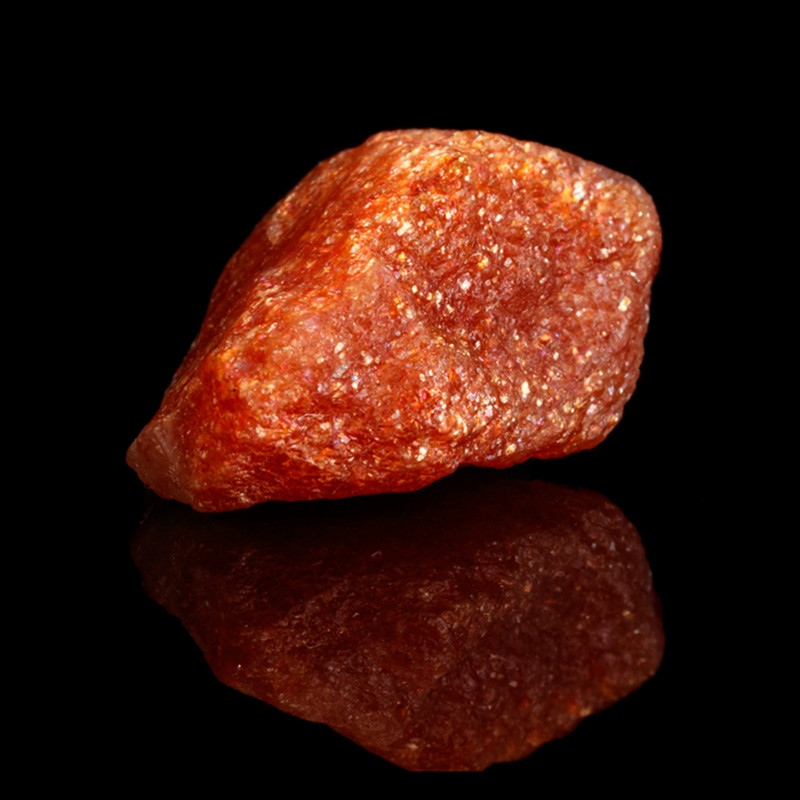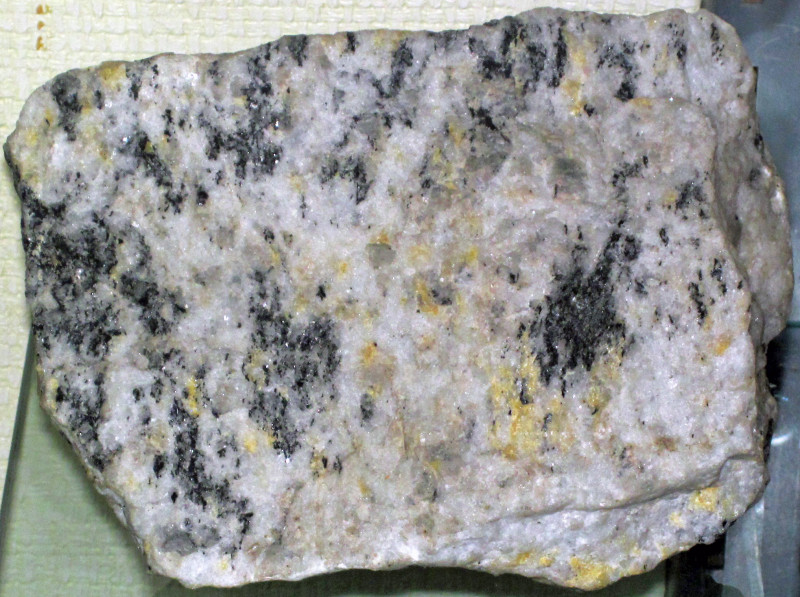
霞石宝石:特性、含义、价值等
 霞石(neff-uh-leen)是一种玻璃状、类似长石的矿物,在各行各业中的重要性日益提升。霞石最为人熟知的是,它是霞石正长岩的重要组成部分,而霞石正长岩中还蕴藏着许多其他宝石。
霞石(neff-uh-leen)是一种玻璃状、类似长石的矿物,在各行各业中的重要性日益提升。霞石最为人熟知的是,它是霞石正长岩的重要组成部分,而霞石正长岩中还蕴藏着许多其他宝石。
霞石是宝石吗?是的,但切割过的霞石宝石却很稀少,因为这种宝石很少形成可刻面的宝石级晶体。
好奇吗?快来一起探索霞石的历史、特性、治愈功效等等!

关于霞石
霞石,又称霞石,是一种重要的矿物,有时被用作半宝石。它通常呈白色、黄色或灰色。除了霞石之外,霞石的同义词还包括:
杰塞基特
索米特
奥尔斯坦
卡罗林石
卡沃利尼特
博当丁
法特斯通
油石
虽然霞石不是黄道十二宫石或诞生石,但它是月亮和金星的替代星石。
霞石的用途
霞石的工业用途比宝石用途更为广泛。幸运的是,其中许多应用有助于应对气候变化!
那么,霞石的用途是什么呢?霞石或霞石正长岩最突出的用途是用作熔剂。霞石中的碱性物质会降低混合物的熔点,从而减少所需的能源和时间,从而降低有毒排放。
这种有益的特性使得霞石适合用于制造瓷砖、水槽、马桶、台面等陶瓷。
类似地,霞石也常用于建筑材料(例如瓷砖、铁轨、鹅卵石路面)。为什么?因为这种矿物坚固耐用,并且具有很强的抗风化和腐蚀能力。
同样,霞石通过添加氧化铝,使玻璃更加坚固。霞石正逐渐成为陶瓷和玻璃中长石的常见替代品。
霞石的另一个环保用途是用于涂料。用霞石制成的涂料不仅能保持其色泽和亮度,经受住风化侵蚀,而且无需添加更多危险(且不环保)的挥发性有机化合物。
 图片来源:John Sobolewski | Creative Commons Attribution 3.0 Unported 许可证
图片来源:John Sobolewski | Creative Commons Attribution 3.0 Unported 许可证
霞石规格和特性
霞石是一种似长石矿物,类似于阿富汗石、透锂长石或方钠石。似长石是类似长石的网状硅酸盐,但二氧化硅含量较低,晶体结构也有所不同。虽然大多数似长石都很稀有,但霞石最为常见。
霞石的化学式是什么?公认的化学式是(Na,K)AlSiO4,但国际矿物学协会2018年的更新指出,钾(K)是霞石的必需元素。更新后的化学式是Na3K(Al4Si4O16)。
霞石的结构为互锁的铝硅酸盐环,理想的钠钾比例为3:1。霞石的氧化钾含量通常为3%至12%,但8%为最佳。
霞石通常呈致密的颗粒状。晶体较为罕见,形状各异,有短而粗的,也有大的,呈棱柱状。
最后,霞石的光学特性使其能够呈现出独特的卫星反射。这些区域的衍射(光线在物体边缘弯曲)较弱,并且环绕着更明亮的反射区域。
其余霞石矿物特性如下:
莫氏硬度:5.5-6
颜色:无色、白色、灰色、棕色、深红色、红棕色、黄色、蓝色、绿色
晶体结构:六方
光泽:玻璃状(玻璃状)至油脂状;蜡状或树脂状(乳白色)
透明度:透明至不透明
折射率:1.52-1.54
密度:2.55-2.66
解理: 不明显/不良 [1010]
断口:亚贝壳状
条痕:白色
发光:某些地区标本的荧光 - 长波紫外线下的淡蓝色(德国)和橙色(安大略)
光学效应:卫星反射;有时有猫眼效应
霞石的种类
霞石有两种:玻璃霞石和玻璃霞石(或玻璃霞石)。
埃莱奥利石
油光石是一种灰色、绿色、棕色或红色的霞石,常以块状或大晶体形式存在。它具有油脂光泽,通常不透明。
光泽和色彩源于大量充满内含物的微观空间,这些内含物可能是角闪石或辉石。内含物可能会产生猫眼效应。
并非所有矿物学家都认为斜长石是一种独特的矿物,但在整个 19 世纪,斜长石被广泛认为是一种独特的矿物。
霞石或玻璃霞石
玻璃霞石,又称“玻璃质霞石”,是一种半透明的块状霞石。它通常无色,略带红色或绿色。光泽可以是玻璃光泽、蜡状光泽或树脂光泽。这种霞石通常形成小晶体或颗粒,其最佳样本发现于意大利维苏威火山附近。
 图片来源:美国缅因州宾夕法尼亚世的霞石正长岩。(美国俄亥俄州斯普林菲尔德维滕贝格大学地质系公开展示)| Flickr
图片来源:美国缅因州宾夕法尼亚世的霞石正长岩。(美国俄亥俄州斯普林菲尔德维滕贝格大学地质系公开展示)| Flickr
霞石正长岩
霞石正长岩不是一种矿物,而是一种经常与霞石一起讨论的岩石类型。
这些深成火成岩完全是晶体(全晶体)且颜色浅,通常为粉红色或灰色,但有些是深绿色。
这些岩石中的主要矿物是霞石、方钠石和碱性长石,通常是正长石。霞石正长岩中可能发现的次要矿物包括磷灰石和磁铁矿。
霞石与石英
那么,如何区分石英和霞石呢?
使用显微镜,您可以检查光学符号——霞石的符号为负,而石英的符号为正。
另一个区别是硬度。石英的莫氏矿物硬度为7,而霞石的莫氏硬度为5.5到6。这意味着硬度为6.5的材料,例如钢锉/钢针或锂辉石,可以划伤霞石,但不能划伤石英。
霞石的意义和历史
霞石象征着启示、真理和自我意识。
“霞石”一词源于希腊语“nephele ”,意为“云”。虽然其含义更具科学性,但这种联系也可以从形而上学的角度进行解读。云象征着神秘、神灵和梦想,因此霞石也拥有这些含义。
历史
1801 年,法国矿物学家 René Just Haüy 为这种意大利新矿物选择了“霞石”这个名称。“云”的含义反映了霞石在浸入酸中时会变得浑浊或朦胧的特性。
同样在 1801 年,丹麦博物学家海因里希·CF·舒马赫 (Heinrich CF Schumacher) 研究了来自挪威的霞石标本,并将其命名为“辉长岩”,尽管辉长岩现在是一种方柱石品种的名称。
1809年,德国化学家马丁·海因里希·克拉普罗特(Martin Heinrich Klaproth)和矿物学家迪特里希·路德维希·古斯塔夫·卡斯滕(Dietrich Ludwig Gustav Karsten)也对产自挪威的霞石进行了分析。他们将该品种命名为“elaeolite”,源于希腊语“ élaion ”,意为“油”,因其油腻的光泽。
19世纪90年代,加拿大矿工在哈夫洛克地区发现了霞石。霞石开采始于1932年,当时安大略省的蓝山矿场建成。它逐渐发展成为加拿大的一个完整产业。
还记得我们讨论过的工业用途吗?加拿大是第一个将霞石正长岩用于工业生产陶瓷和玻璃的国家。很长一段时间里,加拿大是全球唯一的霞石正长岩生产国。
如今,其霞石正长岩产量中约有三分之二用于制造玻璃纤维、容器以及窗户或门用的面板。
现在让我们探究霞石光滑表面的背后,揭示它的形而上学特性!
 图片来源:Kelly Nash | Creative Commons Attribution 3.0 Unported 许可证
图片来源:Kelly Nash | Creative Commons Attribution 3.0 Unported 许可证
霞石的治疗功效
所有宝石都可能成为独特的疗愈石,其特性与其振动和颜色息息相关。最常见的霞石颜色是白色,这意味着它像其他白色宝石一样具有净化和增强功效。
黄色和灰色也是常见的底色。因此,霞石既可以作为根轮的脉轮石,也可以作为激发创造力的骶轮的脉轮石。
霞石据称还具有其他一些治疗功效,包括:
减轻压力
促进更好的睡眠并减少噩梦
平息愤怒
提高自尊和自我意识
激发创造力
让你从忧郁中解脱出来
接下来,我们将讨论浏览待售霞石时要注意的一些因素。
霞石宝石特性
虽然霞石宝石并不常见,但它们的分级与大多数宝石类似,基于颜色、切工、净度和克拉重量。下面,我们将简要概述每个属性:
颜色:大多数钻石为无色或白色,底色为灰色或黄色。灰色可能是由于镁杂质造成的。颜色更深或更有趣的钻石,例如红棕色、绿色或蓝色,可能价值更高。
净度:斜长石中内含物较多,有时可产生猫眼效应。霞石可能含有镜面状内含物或半愈合的裂隙,但如果没有内含物则价值更高。
克拉重量:刻面宝石最多只有1-2克拉。霞石凸圆形宝石尺寸各异。加拿大产的霞石晶体长度可达15英寸(38.1厘米)。
科学家已经创造出了合成霞石,但它并没有用于珠宝制作。
给买家一个重要警告:eBay 上越来越多卖家把霰石当成霞石来卖。如果你看到产自中国的六方晶簇,颜色从橙色到棕色,却被标为霞石,那他们肯定是在骗你。
回到现实问题,霞石是如何形成的?
 图片来源:James St. John,霞石正长岩(冰河杂岩,早密西西比世;加拿大不列颠哥伦比亚省东南部)| Flickr
图片来源:James St. John,霞石正长岩(冰河杂岩,早密西西比世;加拿大不列颠哥伦比亚省东南部)| Flickr
霞石的形成和来源
霞石几乎总是形成于由硅含量较低的岩浆形成的火成岩内部。最常见的岩石是霞石正长岩、响岩和辉石岩。
玻璃霞石可以以晶体的形式出现在较年轻的熔岩中。而油闪石则存在于较古老的岩石中。
最大的含霞石岩群位于俄罗斯科拉半岛。说到霞石,它在哪里被发现?
采矿地点
霞石在世界各地都有发现,但大多数产地产量并不大。加拿大安大略省是个例外,那里开采出大量近乎纯净的霞石。
阿富汗是另一个世界级的霞石产地。美国缅因州是重要的玻璃霞石产地,而挪威则是重要的斜长石产地。
霞石的其他著名来源包括:
中国
芬兰
法国
德国
格陵兰
意大利
缅甸
朝鲜和韩国
美国(阿肯色州、缅因州)
在我们结束之前,霞石的价格是多少?
霞石价格和价值
由于极其稀有,透明、刻面、呈黄色的霞石每克拉价格可达800美元以上。然而,霞石与其他矿物组合刻面后的价格则要低得多。
含有水包裹体的红褐色和白色霞石价格为每克拉20至30美元。含有黑云母包裹体的宝石通常价格为每克拉15至20美元。
凸圆形宝石的价格通常为每克拉2至5美元。抛光霞石混有霓石和异形石的价格更高,约为每克拉150至200美元。纯霞石原石的价格范围广泛,从12美元到900美元不等。
最后,我们将教您有关宝石护理的知识!
霞石的保养和维护
霞石的硬度适中,因此您可能需要在霞石戒指等易损珠宝上添加保护性镶嵌。请勿在易受冲击的活动中佩戴。
用温和的肥皂、温水和软毛牙刷清洁霞石。用柔软无尘的布擦干。请与其他宝石分开存放。避免接触酸性物质。
用霞石滋养您的精神!
霞石作为一种工业矿物,随着时间的推移越来越受欢迎。虽然它不像宝石那么受欢迎,但它却是恢复活力和激发创造力的精神工具!
搜索Gemstone Encyclopedia
最新的文章
彩虹格纹日光石是一种长石,由于内部含有各种包裹体,呈现出三种绚丽的光学效应。它绚丽多彩的光泽和格纹图案使其成为收藏家梦寐以求的珍宝!
12th Jan 2026
文章分类
How To's is where you will find helpful articles from gem Rock Auctions on how to cut gemstones, select gemstones and buy gemstones.
9文章数
